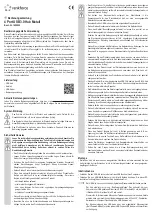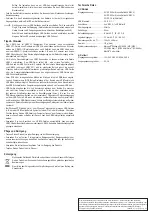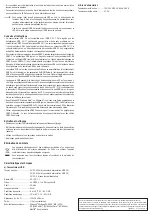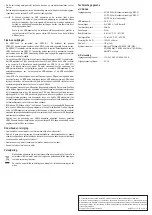
This is a publication by Conrad Electronic SE, Klaus-Conrad-Str. 1, D-92240 Hirschau (www.conrad.com).
All rights including translation reserved. Reproduction by any method, e.g. photocopy, microfilming, or the
capture in electronic data processing systems require the prior written approval by the editor. Reprinting, also in
part, is prohibited. This publication represent the technical status at the time of printing.
Copyright 2017 by Conrad Electronic SE.
*1606505_V1_1117_02_mxs_m_en
Tips & notes
• The USB3.0 hub is USB2.0/1.1 compatible. This means that normal USB2.0/1.1 devices
can be used without any problem on the USB3.0 Hub. However, this will not speed up the
USB2.0/1.1 devices! Of course, the USB3.0 hub can also be used with a USB2.0/1.1 port,
e.g. if your computer does not have a USB3.0 interface. Neither in this case is an increase in
the data transmission speed possible.
• In order to take advantage of the high speed provided by USB3.0, all the devices must
support USB3.0: These devices are the USB device itself (e.g. an external hard disk), the
USB hub and the USB controller inside the PC. However, the theoretical maximum speed for
USB3.0 (or also USB2.0/1.1) is never achieved in practice. This is due to protocol information,
simultaneous operation of several USB devices or the speed limit of the connected device or
the USB controllers/motherboards.
• Normally, USB operation is not possible in DOS or in the protected mode of Windows.
Nevertheless, depending on the computer or BIOS /Setup settings, it possible to use a
USB keyboard and a USB mouse. It is necessary, however, to connect them directly to the
computer’s USB interface, i.e. not to the USB Hub.
• USB devices can be plugged in and unplugged while the PC is in use. This means that you
do not have to switch off your computer, when you want to plug in or unplug devices (with
other interfaces this can cause damage, e.g. if you connect or disconnect a PS/2 mouse
during operation). If data transfers are in progress on the USB port, e.g. if an external disk
is inputting data to the computer, and you unplug the USB plug, Windows might crash or the
data system on the external disk may be damaged!
• For some USB devices (e.g. USB hard drives) Windows XP, Windows Vista™ or Windows
7 displays an icon with an arrow in the menu bar. You can “separate” the USB device from
the computer using this function, and thus instruct the computer to close opened files.
Afterwards, the USB device can be unplugged safely.
• Only use suitable USB3.0 cables for connecting USB3.0 devices. Please note that the data
transfer rate may decrease if the USB3.0 cables are very long.
Care and cleaning
• Disconnect the product from the power supply before cleaning.
• Do not use any aggressive cleaning agents, rubbing alcohol or other chemical solutions as
they can cause damage to the housing and malfunctioning.
•
Clean the product with a dry, fiber-free cloth.
• Do not immerse the product in water.
Disposal
Electronic devices are recyclable waste and must not be disposed of in the
household waste. At the end of its service life, dispose of the product according to
the relevant statutory regulations.
You thus fulfill your statutory obligations and contribute to the protection of the
environment.
Technical data
a) USB hub
Input voltage ................................. 5 V/DC, 900 mA (without power supply unit, USB 3.0)
5 V/DC, 500 mA (without power supply unit, USB 2.0)
5 V/DC, 3 A (with power supply unit)
USB standard ............................... 3.0 / 2.0 / 1.1
Connections .................................. 4 x USB 3.0, 1 x USB mini-B-type
Transfer rate ................................. 5 Gbit/s
Cable length ................................. 93 cm
Operating conditions ..................... -5 to +45 °C, 20 – 80 % RH
Storage conditions ........................ -10 to +60 °C, 20 – 80 % RH
Dimensions (W x H x D) ............... 120 x 20 x 48 mm
Weight .......................................... 110 g (hub)
System requirements .................... Microsoft
®
Windows 98 / 98SE / ME / 2000 / XP (32/64
bits) / 7 (32/64 bits)/ Vista™ (32/64 bits), MacOS
®
9 or
higher
b) Power supply unit
Input voltage/current .....................
100 - 240 V/AC, 50/60 Hz, 0.45 A
Output voltage/current .................. 5 V, 3 A








